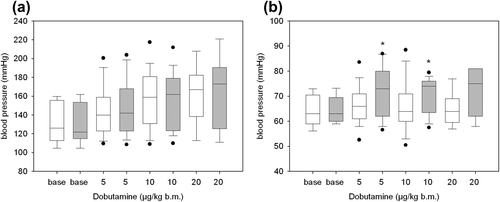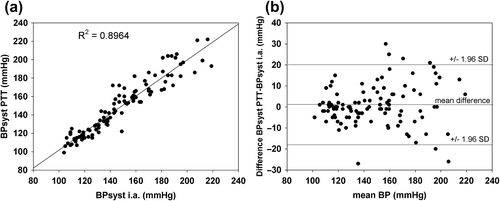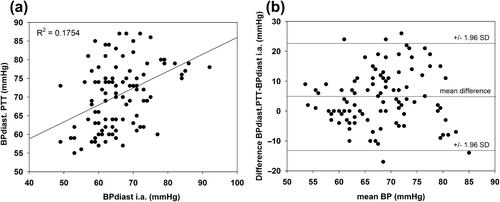Abstract
Continuous blood pressure (BP) measurement allows the investigation of transient changes in BP and thus may give insights into mechanisms of BP control. We validated a continuous, non-invasive BP measurement based on the pulse transit time (PTT), i.e. BPPTT, by comparing it with the intra-arterial BP (BPi.a.) measurement. Twelve subjects (five females and seven males) were included. BPi.a. was obtained from the radial artery using a system from ReCor Medical. Systolic and diastolic BP were calculated using the PTT (BPPTT, SOMNOscreen™). PTT was determined from the electrocardiogram and the peripheral pulse wave. The BP was modulated by application of increasing doses of dobutamine (5, 10, 20 μg/kg body mass). Systolic BPPTT and systolic BPi.a. correlated significantly (R = 0.94). The limits of agreement in the Bland—Altman plot were ± 19 mmHg; the mean values differed by 1 mmHg. The correlation coefficient for the diastolic BP measurements was R = 0.42. The limits of agreement in the Bland—Altman plot were ± 18 mmHg, with a mean difference of 5 mmHg in favour of the BPPTT. The study demonstrates a significant correlation between the measurement methods for systolic BP. The results encourage the application of PTT-based BP measurement for the evaluation of BP dynamics and pathological BP changes.
Keywords::
Introduction
Cuff-based methods of blood pressure (BP) measurement are widely used and robust. Pathological changes in BP can be diagnosed in majority of the cases (Citation1,Citation2). Most of these methods work discontinuously with gaps of some minutes’ duration between consecutive measurements. The sampling rate in ambulatory BP monitoring is four times per hour during daytime and two times per hour during night-time. However, the detection of transient changes in BP due to respiratory events requires BP sampling in the range of seconds. Several non-invasive methods have been developed with the aim of measuring BP continuously. They are mainly based on the principle of Penaz (Citation3,Citation4). These cuff-based techniques also have some disadvantages, which limit their application in practical medicine. The necessity for calibration during the measurement period, which interrupts the measurement, their sensitivity to postural changes and the high price hamper their distribution (Citation4,Citation5). A more indirect method for the determination of BP relies on the relation between BP and the pulse wave velocity (PWV). Studies have shown a correlation between cardiovascular parameters and systolic BP measured using the pulse transit time (PTT) in patients with sleep apnoea (Citation6,Citation7). Also, a strong correlation between systolic BP measured using the PTT and BP measured by reference methods was shown in experimental and clinical studies (8--10). PWV is a function of arterial stiffness, which is affected by several factors including BP. Since the arterial vessel status differs individually and is influenced by vascular age and several diseases such as arteriosclerosis, diabetes and other cardiovascular diseases (Citation11), the determination of absolute BP using PTT requires a calibration. Recently, a one-point calibration was introduced, which drastically reduces the effort of such a procedure in practical medicine (Citation8). Although validation studies of the PTT-based method have been successfully performed, comparisons of BP determination by PTT with the gold standard of BP measurements are rare (Citation9). We therefore conducted a study where the PTT-based method with one-point calibration was validated in comparison to intra-arterial measurements. The results suggest the applicability of this method for clinical investigations.
Methods
Subjects
Twelve subjects, seven male and five female, aged between 21 and 53 years were included in the study (). The local ethics committee approved the study. The subjects gave written informed consent before the test.
Table I. Characteristics of the subjects and correlation coefficients (CC) for systolic (Syst.) and diastolic (Diast.) blood pressure.
Protocol
Measurements were performed in a lying position. The BP of the subject was increased by intravenous administration of dobutamine into the non-dominant arm. Dobutamine was applied in cumulative doses of 5, 10 and 20 μg/kg body mass by changing the infusion rate of the infusion solution (125 mg dobutamine/50 ml NaCl 0.9%). Intra-arterial pressure was monitored using a 20-gauge catheter, which was inserted in the radial artery of the non-dominant arm. The catheter was connected by fluid-filled tubing to a transducer, which was placed at the height of the heart. Transducer signals (ReCor Medical, Palo Alto, CA, USA) were transferred via an optical coupler to a SOMNOscreen™ device.
Simultaneously with the intra-arterial measurement, BP was determined by measuring the PTT using the SOMNOscreen™. The electrocardiogram (ECG) and the finger plethysmography curve (dominant arm) were recorded with the SOMNOscreen™ polysomnography device (SOMNOmedics, Randersacker, Germany). The determination of PTT and calculation of PWV and BP were performed with DOMINO software (supplied with the SOMNOscreen™). A modified lead after Nehb was applied to obtain the ECG. Two bipolar electrodes were fixed parasternally, at the second right intercostal space and fifth left intercostal space. Another electrode was affixed to the lower arm and served as the electrical ground. The plethysmography signal was obtained using a probe for finger plethysmography/pO2 (SOMNOmedics, Randersacker, Germany).
Data processing
Recording and storage of the BP transducer together with ECG and plethysmography signal allowed an exact temporal alignment of the time series. Systolic and diastolic BP values from the intra-arterial recording were defined as the maximum and minimum values of the BP waveform following the last detected R-peak. Data pairs for systolic and diastolic BPPTT and BPi.a. were obtained for each minute of investigation. The duration of the protocol was 9 min, resulting in nine data pairs for each subject. PTTs were averaged for five cycles to reduce the influence of respiration on the signal.
Principle of blood pressure detection using pulse transit time
PTT is defined as the time that a pulse wave needs to travel from the left ventricle to a certain site of the arterial system. In the present study, PTT results from the period between the R-wave of the ECG and the appearance of the pulse wave of the same cardiac beat at the site of the finger plethysmography. PWV is calculated as the quotient of the distance (from the midline of the breast bone to the finger, determined using the body correlation factor) and the PTT. The DOMINO software calculates the BP on the base of a PWV-BP relation and by application of the one-point calibration (Citation8). The calibration was performed immediately before starting the data collection in each patient under resting conditions.
Statistics
Data are presented as presented as box-and-whisker plots showing 5th, 25th, 50th, 75th and 95th percentiles, including outliers. The effect of dobutamine on the BP was tested using the Kruskal—Wallis test. The Mann—Whitney U test was used to test the differences between the BP measured by the two methods for different doses of dobutamine. The linear relationship between BP measured by both methods was analysed using Pearson correlation and tested with the t distribution. A value of p < 0.05 was considered significant. The Bland—Altman plot was applied for investigation of the agreement between the two methods.
Results
Dobutamine treatment increased the systolic and diastolic BPi.a. in a dose-dependent manner. Median systolic BP rose from 126 mmHg (25th percentile: 114 mmHg, 75th percentile: 154 mmHg) to 140 mmHg (123.5 mmHg, 158.5 mmHg) and diastolic BP from 63 mmHg (59 mmHg, 70 mmHg) to 66 mmHg (61.5 mmHg, 70.5 mmHg) in all patients for dose 1. The dobutamine doses 2 and 3 further elevated systolic BP to 159 mmHg (131 mmHg, 181 mmHg) and 167 mmHg (147 mmHg, 170 mmHg), respectively. The values for the diastolic BPi.a. were 64 mmHg (60 mmHg, 69 mmHg) and 64 mmHg (61 mmHg, 67 mmHg), respectively. BP measured by PTT changed similarly. The diastolic BP readings for doses 1 and 2 were significantly greater than for BPi.a. ().

shows the scatterplot of systolic BPi.a. versus systolic BPPTT for all values measured. The data correlated significantly. The correlation coefficient was R = 0.947 (p < 0.01) and the regression coefficient R2 = 0.896 (n = 107) (). Individual correlation coefficients are given in . The mean difference of the systolic BP of both methods was 0.78 mmHg in favour of systolic BPPTT and the limits of agreement were ± 18.9 mmHg (Bland—Altman plot; ).

Diastolic BP obtained by the two methods correlated less than the systolic BP data. The correlation coefficient was R = 0.419 (p < 0.01) and the regression R = 0.176 (n = 108) (). The individual correlation coefficients differed clearly (). The mean difference between BPi.a. and BPPTT was 4.78 mmHg, i.e. the BP PTT was greater in the average of all measurements. The limits of agreement, also depicted in the Bland—Altman plot, were ± 18.05 mmHg ().

Discussion
This study showed that systolic BP measured using the PTT and BP measured intra-arterially correlate significantly. In the Bland—Altman plot, limits of agreement were about 18 mmHg. The correlation of diastolic BP values between the methods was significant, but clearly smaller compared with the systolic BP. Limits of agreement were similar to those of the systolic BP in the Bland—Altman plot.
Non-invasive and continuous BP monitoring have attracted increased attention because of the option to obtain complete time series with high time resolution and the ability to access to more information about the BP control systems. Transient changes in BP related to respiratory or central nervous system events are important for sleep medicine and sleep research (Citation12). Fast and transient changes in BP cannot be obtained by traditional cuff-based, discontinuously working methods.
Based on the finding of Moens and Korteweg, that the velocity of a longitudinal pressure wave is related to the elasticity of the arterial vessel and to the vessel dimension (both influenced by BP) (Citation13), equipment for the indirect measurement of BP has been developed. Recent validation studies showed encouraging results regarding the applicability of this method in medicine (Citation7,Citation9,Citation10,Citation14–16). An important aspect in the application of this principle for BP measurement is the requirement to calibrate the measuring system (Citation17,Citation18). This is due to the individual mechanical properties of the vascular wall, modified also by remodelling and arteriosclerosis, which influence the measurement (Citation19–22). To circumvent the relevant effort of calibration, which does not fit the clinical situation, a suitable one-point calibration has been recently introduced and validated in some studies (Citation8–10). However, there is only one study available in patients in which the gold standard (intra-arterial measurement of BP) was used as the reference method (Citation9). In this study, the BP was not actively modulated in the subjects. Thus, the relatively small range of BP values may limit the significance of the data. The aim of the present study was to validate the PTT-based BP measurement including one-point calibration using intra-arterial BP as a reference. The BP was elevated by application of dobutamine, which is a sympathomimetic, inotropic agent stimulating β1-receptors (Citation23). It has been shown that dobutamine influences the cardiovascular system in a similar way to physical stimulation (exercise) (Citation17).
Dobutamine (5, 10 and 20 μg/kg body mass) increased the median systolic BP in all subjects from about 126 mmHg to 167 mmHg; individual values were between 100 mmHg and 200 mmHg, giving a wide range of BP values. Remarkably, the average diastolic BP for all subjects changed much less, reflecting the situation of physical load.
Correlation analysis revealed a highly significant relation between systolic BPi.a. and systolic BPPTT. This confirms the observations of other studies (Citation7,Citation8,Citation10,Citation22,Citation24). The mean values differed negligibly between the methods. The limits of agreement were 18 mmHg in the Bland—Altman plot. These observations also agree with results from validation studies performed in healthy volunteers and patients, using the same PTT-based method (Citation9). A significant relationship between PTT and BP stimulated by dobutamine was also observed in anaesthetized mongrel dogs (Citation17).
The average diastolic BPPTT differed from BPi.a. (7.5 mmHg) and the correlation between the methods was clearly smaller compared to the situation for systolic BP. Correlations varied considerably when comparing individuals. Small changes in diastolic BP, combined with a variability in BP measurement and determination, may be the reason. One can speculate that individual factors such as the pattern of the plethysmographic curve differ between subjects and that this resulted in a higher variability in the obtained PTT and PWV. However, this has not been systematically investigated. Greater differences between diastolic BPi.a. and diastolic BPPTT have been demonstrated in a study using the same technique as in the present study (Citation9). Both studies also coincide in the observation of limits of agreement of the Bland—Altman plot in the range of 18–20 mmHg.
Strengths of the present study are the intra-arterial BP measurement as a reference and the pharmacological modulation of the BP. However, this study also has some limitations. The small number of subjects constrains the significance of the results. The volunteers were relatively young and did not suffer from cardiovascular diseases. More validation in patients with different diagnoses should be performed before the introduction of the method into clinical use. Furthermore, the time-frame of measurement in the present study is relatively short, which does not allow long-term investigation of the BPPTT.
In conclusion, the present study demonstrates that measurement of BP using PTT offers a method for monitoring the systolic BP under clinical conditions. The systolic BPPTT shows a very good correlation with the gold standard of BP measurement. Furthermore, mean values did not differ and the limits of agreement in the Bland—Altman plot encourage further optimization of the PTT-based method with one-point calibration.
Declaration of interest: A. Patzak advises SOMNOmedics in development of methods for blood pressure measurement and has received honoraria and travel support. The study was not supported by funding.
References
- Parati G, Ochoa JE, Lombardi C, Salvi P, Bilo G. Assessment and interpretation of blood pressure variability in a clinical setting. Blood Press. 2013;22:345––54.
- Zanchetti A. The role of ambulatory blood pressure monitoring in clinical practice. Am J Hypertens. 1997;10:1069–80.
- Penaz J, Voigt A, Teichmann W. Beitrag zur fortlaufenden indirekten Blutdruckmessung. Z Innere Med. 1976;31:1030–3.
- Molhoek GP, Wesseling KH, Settels JJ, van Vollenhoven E, Weeda HW, de Wit B, et al. Evaluation of the Penaz servo-plethysmo-manometer for the continuous, non-invasive measurement of finger blood pressure. Basic Res Cardiol. 1984;79:598–609.
- Kurki T, Smith NT, Head N, Dec-Silver H, Quinn A. Noninvasive continuous blood pressure measurement from the finger: optimal measurement conditions and factors affecting reliability. J Clin Monit. 1987;3:6–13.
- Pitson DJ, Stradling JR. Value of beat-to-beat blood pressure changes, detected by pulse transit time, in the management of the obstructive sleep apnoea/hypopnoea syndrome. Eur Respir J. 1998;12:685–92.
- Hennig A, Gesche H, Fietze I, Penzel T, Glos M, Patzak A. Messung von apnoebezogenen Blutdruckänderungen mittels Pulstransitzeit und Penaz-Prinzip. Atemwegs- und Lungenkrankheiten. 2012;38:1–8.
- Gesche H, Grosskurth D, Kuchler G, Patzak A. Continuous blood pressure measurement by using the pulse transit time: comparison to a cuff-based method. Eur J Appl Physiol. 2012;112:309–15.
- Bartsch S, Ostojic D, Schmalgemeier H, Bitter T, Westerheide N, Eckert S, et al.[Validation of continuous blood pressure measurements by pulse transit time: a comparison with invasive measurements in a cardiac intensive care unit]. Dtsch Med Wochenschr. 2010;135:2406–12.
- Schmalgemeier H, Bitter T, Bartsch S, Bullert K, Fischbach T, Eckert S, et al. Pulse transit time: validation of blood pressure measurement under positive airway pressure ventilation. Sleep Breath. 2012;16:1105–12.
- Mackey RH, Venkitachalam L, Sutton-Tyrrell K. Calcifications, arterial stiffness and atherosclerosis. Adv Cardiol. 2007;44:234–44.
- Levy P, Ryan S, Oldenburg O, Parati G. Sleep apnoea and the heart. Eur Respir Rev. 2013;22:333–52.
- Callaghan FJ, Babbs CF, Bourland JD, Geddes LA. The relationship between arterial pulse-wave velocity and pulse frequency at different pressures. J Med Eng Technol. 1984;8:15–8.
- Zheng YL, Yan BP, Zhang YT, Poon CC. An armband wearable device for overnight and cuff-less blood pressure measurement. IEEE Trans Biomed Eng. 2014;61:2179–86.
- Spiesshofer J, Heinrich J, Bitter T, Efken C, Lehmann R, Eckert S, et al. Validation of blood pressure monitoring using pulse transit time in heart failure patients with Cheyne—Stokes respiration undergoing adaptive servoventilation therapy. Sleep Breath. 2014;18:411–21.
- Nguyen XP, Kronemayer R, Herrmann P, Mejia A, Daw Z, Nguyen XD, et al. Validation of a new non-invasive blood pressure measurement method on mice via pulse wave propagation time measurement on a cuff. Biomed Tech (Berl). 2011;56:153–8.
- Ochiai R, Takeda J, Hosaka H, Sugo Y, Tanaka R, Soma T. The relationship between modified pulse wave transit time and cardiovascular changes in isoflurane anesthetized dogs. J Clin Monit Comput. 1999;15:493–501.
- Barschdoff D, Ehrig M. Kontinuierliche Blutdruckbestimmung wahrend des Belastungs-EKG [Continuous blood pressure monitoring during stress ECG]. Biomed Tech (Berl). 1998;43:34–9.
- Yamashina A, Tomiyama H, Arai T, Koji Y, Yambe M, Motobe H, et al. Nomogram of the relation of brachial-ankle pulse wave velocity with blood pressure. Hypertens Res. 2003;26:801–6.
- Mitchell GF, Parise H, Benjamin EJ, Larson MG, Keyes MJ, Vita JA, et al. Changes in arterial stiffness and wave reflection with advancing age in healthy men and women: the Framingham Heart Study. Hypertension. 2004;43:1239–45.
- Schiffrin EL. Vascular stiffening and arterial compliance. Implications for systolic blood pressure. Am J Hypertens. 2004;17:39–48S.
- Foo JY, Lim CS. Pulse transit time as an indirect marker for variations in cardiovascular related reactivity. Technol Health Care. 2006;14:97–108.
- Tuttle RR, Mills J. Dobutamine: development of a new catecholamine to selectively increase cardiac contractility. Circ Res. 1975;36:185–96.
- Yamashina A, Tomiyama H, Takeda K, Tsuda H, Arai T, Hirose K, et al. Validity, reproducibility, and clinical significance of noninvasive brachial-ankle pulse wave velocity measurement. Hypertens Res. 2002;25:359–64.
